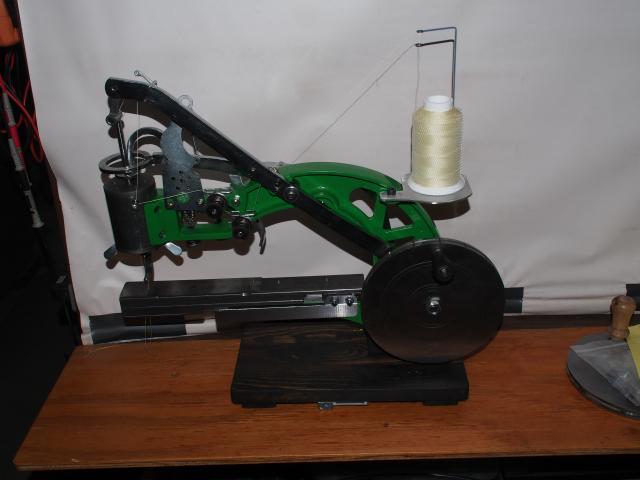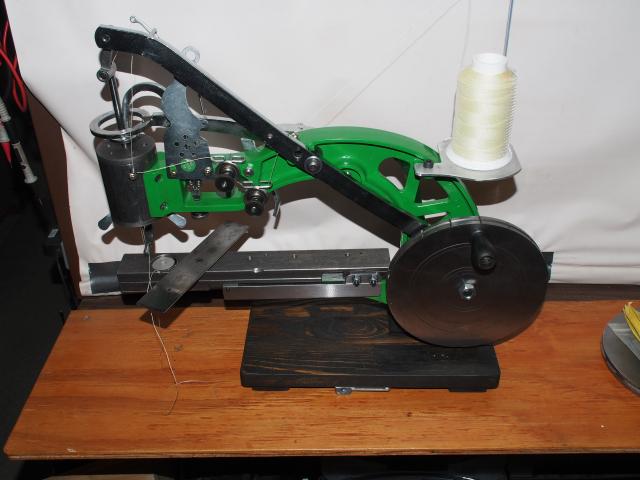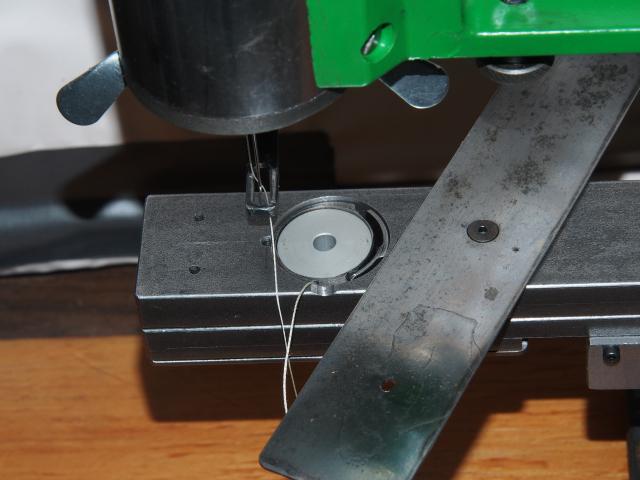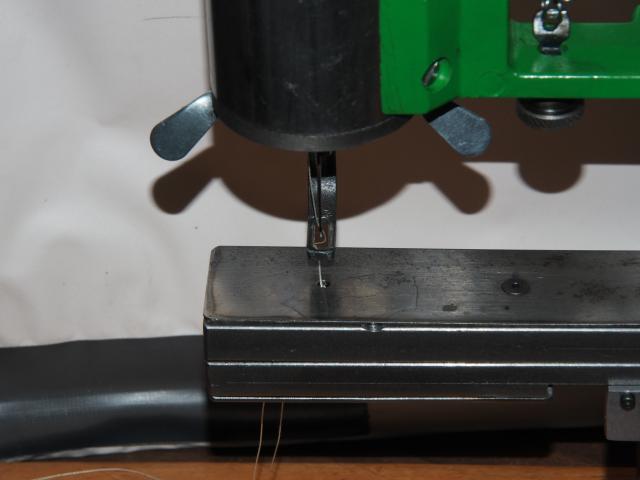
GerryR
Members-
Posts
176 -
Joined
-
Last visited
Content Type
Profiles
Forums
Events
Blogs
Gallery
Everything posted by GerryR
-
I've had mine for years, red handle (fine) and purple handle (medium). I also have their pen style (roundish) that I use for odd shaped cutters; for example I used it for getting into the curved end of my farrier knife and to touch up coarse serrated blades. Very handy, long lasting Items.
-
Advice for speed reducer for Seiko CW-8B
GerryR replied to WMages's topic in Leather Sewing Machines
I don't know anything about your Seiko but would recommend you look at some AC drives (VFDs - Variable Frequency Drive) and AC-3 phase gearmotors. The VFD will convert a single phase input (like regular household power) to 3-phase power that the motor requires. AC gearmotors can be bought with different ratios; I use one that is a 5:1 reduction. The gearmotors are much more compact than speed reducers made with pulleys and belts. The VFD requires a potentiometer input to vary speed. I found a TIG welder footpedal, new, for $35.00, which had the included pot I needed to control the VFD. Just another option. CowboyBob, on this forum, I believe offers DC servo systems and good support from the comments I have seen. -
I never end up on the good side of making money on my ideas. Seems the lawyers are who make the coin. Besides I'm too old to care; I just do these projects to stay busy and keep out of trouble (most of the time anyway!)
-
Yes - When trying to sew 20 oz. leather, the 135x16 needle's shoulder would enter the leather, distorting the entry hole, due to the added stroke associated with using the M-bobbins. CowboyBob recommended the 190 needles which were approximately 5+ mm longer. By cutting a few mm off the shank, the shoulder is now above the 20 oz. leather at full down stroke on the machine because of the longer 190 blade.. It worked out well. Added the Photo of the Needles: Needle on left is 136x16, center standard 190, right is shortened 190. Notice the extra length in the blade compared to the 135x16.
-
As I seldom use 207 thread, I left the tension on the bobbin alone; it works as is for 69 thru 138 (I don't use 69 much either). The 207/207 in the picture above had too much bobbin tension, but I didn't fool with it much. I just wanted to make sure it functioned with the three thread sizes (92,138 and 207). Once I get it motorized, i'll do some long runs with the proper adjustments for all the thread sizes. There is enough range in tension setting for the upper thread, I think, to compensate for the 207 in the bobbin. On the Chinese patchers there are two upper thread tension setups (Some people say one is for bobbin winding, but I can't see how that works for bobbins the way it is set up). I always use both (actaully 1-1/2) for upper tension adjustment and have had no problems. On my unmodified patcher, I changed the needle system to 135x16/17 because of all the leather options, but because of the added stroke of the modified unit above, I'm using a shortened 190 needle system. Projects like this one keep me in the shop and out of trouble, mostly!
-
Just to finish up and make some final comments: Here is a picture of the different size threads run on the machine. Everything ran pretty well except when running the 207 thread in the bobbin. I need to increase the upper thread tension or lower the bobbin tension to get the knot to pull further into the leather. I did the stitching one-handed with the machine clamped to a table, hence the crooked stitch paths. Once I get it motorized, I can use two hands and guide the leather better. Like I stated earlier, it is no longer a true "patcher" due to the size of the arm however, the dimensions of the new arm are 1.5" wide by 1" deep, so it can still be used in fairly tight places. It was a fun project and with the larger M-style bobbins, I can do "longer" projects between bobbin changes. Also, being able to use 207 top and bottom makes for more sewing options; 207 in the original patcher bobbins wouldn't get you very far.
-
Is that not a DC servo controller/motor that is driving your machine? If so, why not just change the parameters in the controller to get better low speed control. Most of the DC servo systems can "crawl" and have ample torque for the machine. Just curious.
-
I don't know how your machine is assembled but my lathe has oil level windows that pop out of the front of the machine and you just replace an O-ring to stop a leak from the window. I use a thin blade to work around the window to get it out. I dont know of any "repair" sealer that will work once the oil starts leaking; maybe someone else does.
-
@CowboyBob The 190 system works perfectly. I trimmed 5mm off the top of the shank and can now do 20 oz. leather (machine limit) without the shoulder hitting the leather and widening the top of the hole. Thank you for your input!
-
I was told it could be done, just have never seen it done. From the article linked, it is very involved; unless you are running some large motors with very expensive VFDs (for which Rockwell Automation is noted for) I think it would be cheaper and safer to use one VFD per motor. But, thanks for the link; never to old to learn something new!
-
I'm working on a project, just for my amusement, where I changed the needle stroke (I'm presently using the 135x16 needles) of the machine. Because of this the added stroke causes the shoulder of the needle to just enter the leather on 16 oz and and above, widening the hole at the needle entry point. I read that the 328 needles have a 1.98mm shank diameter up to size 140 and a larger shank(s) after that. the 135x16 needles have a 1.98mm shank. If the 328 needles have a slightly longer blade, I could cut the shank to get the same total needle length (~45mm) and keep the shoulder away from the leather. This is part of my conversion project of a Chinese patcher to using M-style bobbins. If the total length of the 328 is near 60mm, as Tigwelder indicated, then maybe I chose the wrong system to modify. Like I said, just amusing myself.
-
Looking for the actual length of the shank, shoulder and blade of the 328 needles sizes 19/120 and 22/ 140. I found the overall length of 5.2cm and shank diameter of 1.98mm by searching but can't find the other info. Any help will be appreciated! Thanks in advance.
-
I have never seen a multi-motor machine running off of a single VFD; one motor per VFD. Most VFDs require the motor parameters to be entered into it and it is only programmed for one set of motor parameters. Besides, at the price of these VFDs these days, one per motor is pretty affordable, at least in the 5 hp and less range.
-
That's a great idea, using one "portable" VFD to run multiple machines!
-
help from the masters..... Is the machine fixable?
GerryR replied to MattiJoy2's topic in Leather Sewing Machines
I'm a little late to the party, but here is my $.02 If everything runs freely, the casting can be brazed, or if just a hairline crack, silver soldered; I wouldn't weld it. -
I don't know much about clutch motors but have assumed they run at full speed and that you "feather" the clutch to regulate the output(??). If that is the case, then running it with a VFD is not a problem. As stated above, you need to worry about low RPM because of the cooling. Many "inverter rated" motors are spec'd at 10-90 Hz. I have run many VFD's on fractional to 100+ Hp motors (factory automation). I presently have one on an old Boyer-Shultz 3 ph. surface grinder in my shop (running full speed) that has been running for over 20 years, and I have a VFD running as my speed controller on my leather sewing machine; the sewing machine has an inverter-rated gear motor with a 5:1 reducer, so motor low-speed control is not a problem. The point is you can use some form of reducer to raise the low-end motor RPM to keep it cooler. I have recommended VFD's as optional speed controllers for sewing machines with clutch motors, lock the clutch on and use the VFD with a TIG welder footpedal to control the speed. Many Tig welder footpedals have a built-in potentiometer for regulating output power which can be used to control the VFD output frequency. Just some thoughts that might help if you run into problems. (By the way, I'm using a unit similar to what you purchased (in my case 220VAC 1ph. in to 220VAC 3ph. out) and it works perfectly!)
-
First Stitches! (Still doing some "tweeking," but looks promising.) These are a single layer of 8 oz. veg tan and a double layer.
-
Well, because I didn't have an easy way to make a new hand / cam wheel to get the added needle stroke that I needed, a machine mod was going to be needed. I had a second machine and chose to modify it to be sure the mods would work before messing with my good machine. To get the added needle stroke, I moved the pivot point of the arm by 0.75 inches toward the hand wheel. I had to machine the frame in order to relocate the pivot point, but it worked out pretty well. I have one small issue that I will address Monday and that will finish it. It is no longer a true "patcher" but after running it for awhile with different threads I will swap the parts over to my good machine which is motorized. Here's a few pictures of what I ended up with.
-
Adding pulleys to slow down a Consew 206RB
GerryR replied to melinda's topic in Leather Sewing Machines
I use an AC variable frequency drive (VFD) with a 3-phase 5:1 speed reducer gear motor. The controller converts single-phase house current to the needed 3-phase for the motor. The VFD gives the needed speed control. This is another option that seems to be overlooked. The controllers can be bought for less than $100.00 that will handle up to a 1 HP motor. Many of the older industrial clutch motors were three phase, so it would be easy to lock the cluch on and connect to a VFD to get very good speed control. Just another option. -
I've had a little more time on my hands than usual and decided to mod a Chinese Patcher to handle M-style bobbins to get the added thread capacity. One of the goals was/is "no modifications to the existing machine" so I can get back to the original patcher just by swapping parts. Well, I got everything done "except" I need to either make a different swapable hand / cam wheel or make a different needle bar connection to get the additional needle down stroke, about 0.3". The cam for the bobbin rotation works as is, as the angles of motion are proportional. I don't know if in the end I will get it all working, but at least I can easily put it back to original. I think these patchers get a bad wrap, but mine has worked flawlessly. It's definitely a educational project. Comments and suggestions are welcomed.
-
@CowboyBob I had built a bobbin winder machine using a Rapala digital fishing line counter (see picture) and just received some M-bobbins, and though I haven't yet wound all the above size threads, I did wind sizes 138 and 207. I got 42 feet of 138 and 32 feet of 207 on the bobbins. They are probably not wound as tight or as uniform as the "store bought" bobbins but the discrepancy of 69 ft to 42 feet seems quite a lot. When I have the time I will redo the 138 and 207 and run some 69 and 92 thread. Just thought you would like to know. I will follow uo in a few days.
-
Thank you Bob! It looks like there is about a 10 yd difference between sizes so maybe I can assume 13 yds. for 207 until I can verify it.
-
I would like to know the capacity of M-style bobbins for #69, 92, 138 and 207 thread, I looked up for prewound bobbins for #138 thread and they stated 36 yds. but said the same for 92 thread, which didn't sound right to me. (They were probably just loading a fixed amount on the bobbins, not filling to capacity.) I would like to know the full capacity, +/-, of the M bobbins for the size threads stated. Can anybody help? Thanks.
-
Timing A Singer 29K70 - Can Anyone Help?
GerryR replied to erbunker's topic in Leather Sewing Machines
Here is a service manual and parts list for the 29K71,72, 73. I don't know the differences compared to the 29K70. Hope it helps. Singer 29k71-2 Patcher.pdf





